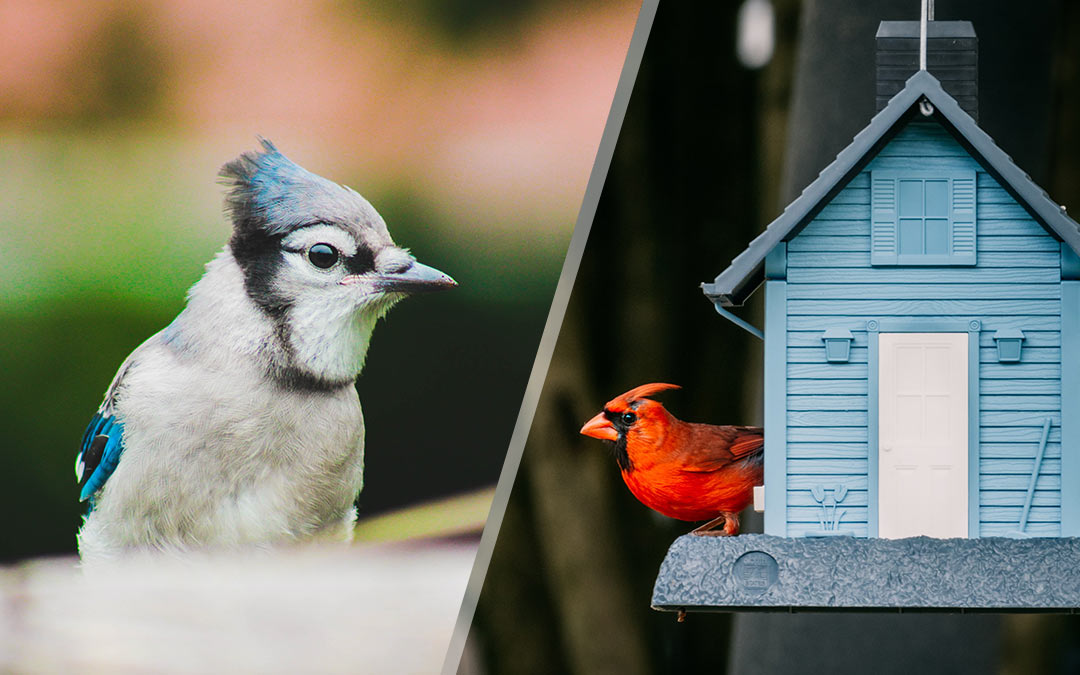
When the spring season is again upon us, often coming abruptly here in the Southeast, it’s as though the world comes alive again with flora, fauna, and all kinds of wildlife. Spring is regarded as a time when all things are new, and there’s something interesting and beautiful about watching nature begin again. When glorious spring does arrive, you’re likely to notice some increased bird activity outside your assisted living windows, as the spring season is often deemed the most exciting time for birdwatching. There are a lot of bird species you may see around these parts, and here is a roundup of some of the most popular types to keep an eye out for during your birdwatching in the southeast. Most of these species can be observed in the area year round, but spring is a great time to keep a lookout for them from your coziest seat by the window!
1. Northern Cardinal
A very popular feeder bird, the Northern Cardinal is an easy one to spot. These gorgeous birds have a crest of feathers on their heads, and short, thick bills that are ideal for cracking open seeds. The males are a stunning red with a black masks and throats, and females are a pale brown color with hints of red on their crests, wings, and tails.
2. Blue Jay
Bold of personality, Blue Jays sometimes get a bad rep, yet their extreme intelligence often makes them quite interesting to watch. Their bold, blue plumage makes them easy to spot with black bars running across their backs, a black necklace of feathers, blue crested heads, and white bellies. Males and females look the same.
3. American Goldfinch
The American Goldfinch is another popular bird in the area, and a favorite at that. These delightful little birds are artful feeders, and can even feed upside down! In the spring and summer, the males are a bright yellow with a black cap and black wings, and the females are a more subdued yellow, and don’t have the black caps.
4. House Finch
House Finches have a pleasant song, and can be seen across almost the entire continent of North America. Adult males feature rose red heads and upper breasts, with brown streaks on their backs, tails, and bellies. Females are brown with darker streaks on their backs, tails, and bellies, but without the red flourishes. These birds feature conical beaks designed to eat seeds and notched tails.
5. House Sparrow
House Sparrows are in invasive species originally from the Middle East, and are now one of the most common bird types in the world. You can spot these sweet little birds in and around your yard. Males have gray crowns, black bib, white cheeks, and chestnut brown sides, faces, and necks. Their backs are mostly brown with black streaked patterns. Females are a duller brown color with black streaks, and their undersides are a lighter shade of brown. They can be easily distinguished by the tan line that extends behind their eyes.
6. Mourning Dove
You may have heard the coo of a Mourning Dove, a soft call that is sometimes mistaken for the hoot of an owl. These common birds are grey in color with black dots on their wings. They have thin, black bills, long slender tails, and legs that are a pinkish color. You’ll also notice a beautiful blue ring around their eyes.
7. Black-Capped Chickadee
These personable little birds feature short, thin bills, black bibs and caps on their heads, and white cheeks. The rest of their plumage is predominantly grey, and they have light tan bellies. They typically don’t stay long at feeders, swooping in to grab a bite to eat elsewhere; however, they can be trained to feed from the hand with some patience.
8. American Crow
Many people dislike crows, but they are highly intelligent birds, and they help keep hawks away. These large birds are all black with glossy feathers, thick, long bills, and they are smaller than ravens, which they are sometimes confused with. You’ve likely seen them around.
9. European Starling
This invasive species often likes to travel in flocks, and can sometimes chase away other feeding birds nearby. They are stocky of build, and about the size of an American Robin, and they feature black feathers with a sheen. They have short tails, and long slender beaks. They often have a green-purple tint, and in the winter they develop white spots all over.
10. Ruby-Throated Hummingbird
This beautiful showstopper of a bird is small in size, but mighty in color and showmanship. Males have metallic green backs, black masks, and vibrant red throats (hence the name), and females are green with white underbellies. Both males and females have long bills designed to insert into flowers for feeding.
Our area is teeming with beautiful birds, and watching them can be a fascinating practice. Robert Lynd wrote, “In order to see the birds, it is necessary to become a part of the silence.” It’s amazing what we can see and appreciate when we slow down, and open our eyes. Happy bird watching in the Southeast this spring! May you find joy through these little creatures as they flit about with happiness, not a care in the world.
